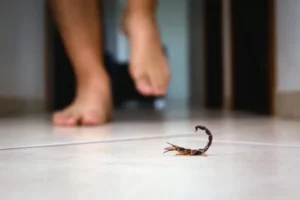Home / Blog / How To Keep Horse Flies Away
How To Keep Horse Flies Away

Scientifically reviewed by Daniel Baldwin, BCE, CCFS, CP-FS
-Published on September 26, 2022
-Updated on March 11, 2025
Horse flies may look intriguing with their iridescent heads and bright green eyes, but their bite isn’t pleasant at all. Found in outdoor areas that are moist or near undisturbed water, these types of flies are a nuisance to humans and pets alike. Learn more about how to control horse fly populations near your home and pool and whether their bites are dangerous.
What are horse flies?
Horse flies, sometimes called gad flies, are a species of fly that thrives around swampy, wet areas. Like many other insects, they sport a metallic-looking head, which makes it tricky to identify them from other similar flies. Some horse fly species have a distinctive feature: bright green eyes.
Horse flies usually range in size from ¾ to 1 inch, which means they are bigger than a fruit fly, but on par with a house fly. However, some can grow as large as a bumblebee. They are strong, fast fliers.
Horse flies can live from 30–60 days, which includes their full life cycle from egg to pupa to adult. Females lay their eggs in clusters on the grass. Over the winter, the eggs remain in the larva stage and they hatch in spring, and grow into adults by June each year. Adult horse flies thrive in cool, moist areas like streams, marshes, and forests.
Why do horse flies bite?
Female horse flies are the biters; they bite and suck up to 3 ounces of blood from one host at a time. Just like mosquitoes, they bite to facilitate egg production. Since they rely on their blade-like mouth to cut skin open and then slurp the blood, they also have been found to produce an anti-clotting agent at the site of the bite. This allows them to consume as much blood as possible.
Males, on the other hand, don’t bite at all. They eat nectar, honeydew, and plant sap instead.

What’s the Difference Between a Horse Fly and a Mosquito?
The main difference between horse flies and the mosquito is the method by which they consume blood. While mosquitos are equipped with needle-like proboscis mouthparts that pierce the skin in a relatively painless way, horse flies cut and slurp, which makes their bites much more noticeable and painful.
Horse flies can also carry swamp fever, or equine infectious anemia, which is can cause fever, weight loss, and anemia in horses.
What attracts horse flies?
Sunny, warm, damp climates are horse flies’ preferred conditions. Unlike other pests, they will rarely enter your home. Instead, it’s your yard, pond, lake, or pool that will be their preferred location.
Since a blood meal is the prime attractor for female horseflies (the ones that bite you), they’ll locate animals and humans by tracking the heat and sweat from human bodies.
How to get rid of horse flies
Try the following tips to deter horse flies (and mosquitoes):
- Cover yourself up with lightweight, light-colored clothing when outdoors
- Take a detour around any long grasses
- Ditch your favorite perfume on your outdoor adventure
- Keep a good distance from still water as this is the prime hotspot for horse flies to live all summer
- Break out the bug spray
How to keep horse flies away from a pool
To keep horse flies away from your pool, you can:
- Remove any waste from your pool area
- Use sticky traps or other methods to deter horse flies from crashing your party
- Try some more specialized horse fly traps, like one that has a metal ball that warms in the sun to attract the female blood-thirsty egg-layers
Whichever methods you choose, it’s worth the effort to avoid those painful horse fly bites.
Related Articles
Visit our blog to learn more.
→





